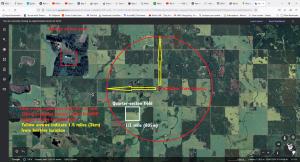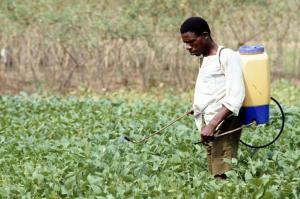
According to the Organic Produce Network, Almost All USDA-Certified Organic Honey is Imported

USDA Organic honey is mostly cheap imported honey, certified in, and imported in bulk from, developing and middle-income countries
Lacking formalized organic certification rules for honey, the USDA recognizes organic certification from other countries such as Mexico, Brazil and India.
Many people choose to pay more to buy organic honey. For some, this is a choice to support more natural, sustainable agricultural methods that conserve the environment. For others the choice may be for food safety: organic foods should be less likely to contain harmful contaminants. For many it’s both. Importantly, organic certification doesn’t relate to the health benefits of honey: raw non-organic honey unequivocally provides more health benefits than processed, pasteurized organic honey.
The USDA published the Formal Recommendation by the National Organic Standards Board (NSOB) to the National Organic Program (NOP) regarding apiculture (beekeeping) on October 28, 2010. The recommendation describes organic bee management principles including banned chemicals, organic feed and hive construction regulations, record keeping requirements, land management, and permitted forage sources. Pharmaceutical treatments (e.g antibiotics) of honeybees are generally banned, except for specific treatments derived from natural (usually plant or fungal) sources. Beekeeping equipment used for organically managed hives and the bees themselves must be kept separate from non-organically managed colonies and equipment.
The complications arise from the fact that honeybees forage for nectar over large distances. It’s generally accepted that bees will fly up to 3 miles (5km) to retrieve nectar. However, the farther the bee flies to forage, the more energy it expends and the less the net food gain for the hive. Research shows that the vast majority of nectar is foraged from within about 1.8 miles (3km) of the beehive. In 2010 the NSOB recommended a 1.8-mile foraging radius around beehives. Within the forage radius there must not be any proscribed substances (herbicides, pesticides etc) on the crops, land or in the water for the honey to be considered organic. Genetically modified crops and sewage within the forage zone also preclude organic certification. Though the forage zone was recommended by the NSOB in 2010, until now it has not been adopted as a rule by the NOP, so organic certification regulations of American-produced honey have never been formalized.
The proposed 1.8-mile (3km) forage zone raises uniquely important issues. The forage zone area is slightly over 10 square miles (28km2). A common agricultural field in North America, the “quarter section” is a square one-half mile (800m) per side. There can be up to 54 quarter sections wholly or partially within the forage zone, managed by dozens of different farmers/companies. Beekeepers virtually never have control of land management within the foraging area: The farmer/operator plants the crops and manages them as they see fit, some organically, but most non-organically. A proscribed substance, such as a pesticide or a proscribed GMO crop, in a single field among those 54 quarter sections would disqualify all honey in that apiary from organic certification.
It's not only crop management that is relevant to the forage zone. Towns, cities, parks, and golf courses almost ubiquitously utilize substances such as herbicides or fertilizers that are proscribed by the NSOB. There are certainly remote areas (e.g in rugged mountains) of the United States where a 1.8-mile radius circle can be found that are free from these proscribed substances or crops. Honey can only be harvested when the colony has an excess of honey due to an abundance of blossoms, which generally occurs in agricultural areas. Within the United States, finding a 10-square-mile circle with enough blossom to support commercial honey production that’s also free of proscribed substances and crops is exceedingly rare.
Most American beekeepers provide pollination services, moving their bees seasonally to pollinate specific crops. The largest of these is the California almond pollination, which attracts up to 2/3 of the nation’s honeybee colonies when the almonds bloom in spring. Almond producers generally do not follow organic standards. Participating in the almond pollination (or pollination of almost any other crop) would preclude organically certified honey.
Even a beekeeper that doesn’t participate in pollination services and strictly follows organic beekeeping principles will almost certainly fail rigorous organic certification due to a proscribed crop or substance within the foraging area. This is where choosing organic honey to support better environmental practices breaks down: purchasing organic honey to encourage organic beekeeping has no effect on the management of agricultural land within the forage zone.
The USDA doesn’t perform organic certification of foods itself, but outsources this to other agencies, including for-profit companies. According to journalist Lisa Held who has published articles about USDA certification of organic honey, “Unfortunately, the whole process is a little murky…individual certifiers each do things slightly differently, and many of my sources said there are some that use those ‘in progress’ standards to certify honey produced in the US. The other big issue is that most US operations wouldn’t qualify under those standards, because guaranteeing a 1.8-mile organic radius is pretty difficult.”
The USDA does, recognize other countries’ organic certification of honey. Large exporters of “organic” honey into the USA include Mexico, India and Brazil. Tellingly “organic” honey on the bulk honey commodity market from these countries fetches a lower price than non-organic honey sourced from North America.
Despite many retail organic honeys not appearing to list “country of origin”, especially on Amazon, The USDA regulations state that the labeling of imported honey must state the country or countries of origin of the lot or container of honey, preceded by the words ‘Product of' or other words of similar meaning.
Dr. Nasr added to his quote (above) that this type of honey certainly does not meet the USDA requirements to be called organic honey. “Enforcement of the requirements are not guaranteed in some of these countries and consumers should be aware of this type of practices.”
The question to ask yourself when you see “USDA Organic” honey is whether you trust the integrity and validity of the certification from the country where the honey was produced.
Jeremy Wendell
Wendell Estate Honey
+1 204-564-2599
email us here
Visit us on social media:
Facebook
Instagram
YouTube
Even lacking organic certification due to our location, Wendell Estate Honey is a clean, pure and free from toxic contaminants as any organic honey out there
EIN Presswire does not exercise editorial control over third-party content provided, uploaded, published, or distributed by users of EIN Presswire. We are a distributor, not a publisher, of 3rd party content. Such content may contain the views, opinions, statements, offers, and other material of the respective users, suppliers, participants, or authors.



